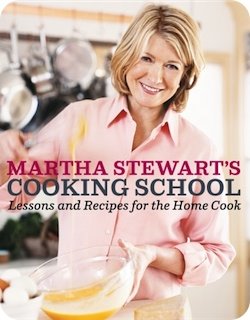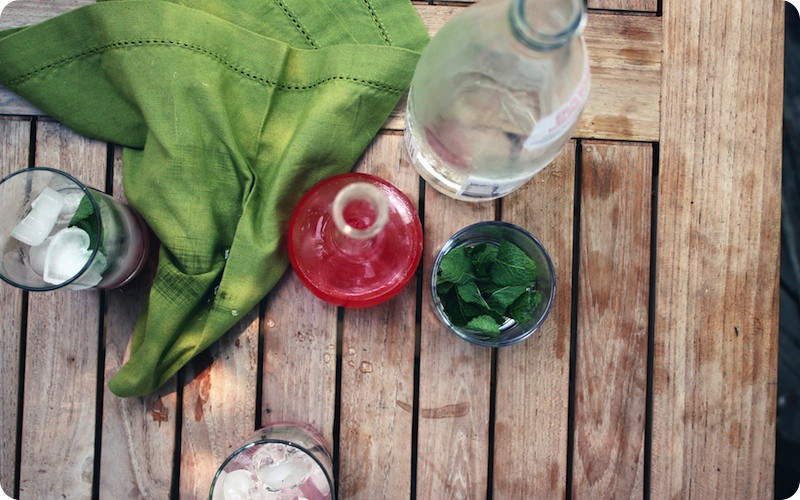
A fine balance; salty, sweet, savoury and all-around delicious, Ina Garten's Maple Roasted Butternut Squash from the book Barefoot Contessa Back to Basics.
Martha. Ina. Nigella. Three first names that hardly need last names to be recognized. Three names that are now entities unto themselves; brand names, names that are used as verbs ("I Martha'd up something to decorate the mantle"), as adjectives ("That's such an Ina tablecloth"). Names that have been carefully-cultivated in their marketing to evoke a sense of familiarity and, almost, friendship.
Martha Stewart, Ina Garten and Nigella Lawson have turned cookbooks into cooking shows, cooking shows into housewares lines, specialty food products, magazines and much, much more. I am surely not alone in saying that these women are each a huge influence to me in the kitchen; in the way I cook and, in many ways, the way I look at food.
It seemed as though the holidays had arrived early last month, when all three of these prolific authors published cookbooks - all coming out within a two-week span. As you can imagine, an admitted fan like me was in food heaven.
True to their established brands, the ladies did not disappoint with their offerings. Martha Stewart is once again the teacher with Martha Stewart's Cooking School; Ina Garten is the ever-gracious host, who doesn't stray from her roots, with Barefoot Contessa Back to Basics and Nigella Lawson continues her role as the ebullient gal pal in the seasonal Nigella Christmas.
Here's a peek at each:
 Martha Stewart's Cooking School (Clarkson Potter, 2008), lives up to its name; the hefty book not only feels, but also reads, like a textbook. Although publicity material would like you to consider Martha at your side, guiding you through the recipes, the book instead delivers a vaguely school-marmish incarnation of Stewart at the head of the classroom. After a fairly welcoming introduction, it is down to business and the book dives into its curriculum. First off, a summation of the rules of the kitchen, laying out gentle reminders of what one should keep in mind when approaching a recipe, stocking a kitchen, and while cooking. Following that is an in-depth, expansive list of suggested baking and cooking equipment for the well-prepared cook.
Martha Stewart's Cooking School (Clarkson Potter, 2008), lives up to its name; the hefty book not only feels, but also reads, like a textbook. Although publicity material would like you to consider Martha at your side, guiding you through the recipes, the book instead delivers a vaguely school-marmish incarnation of Stewart at the head of the classroom. After a fairly welcoming introduction, it is down to business and the book dives into its curriculum. First off, a summation of the rules of the kitchen, laying out gentle reminders of what one should keep in mind when approaching a recipe, stocking a kitchen, and while cooking. Following that is an in-depth, expansive list of suggested baking and cooking equipment for the well-prepared cook.
Chapters are structured as studies of specific ingredients; highlighting the particular techniques and recipes that best showcase the qualities of that ingredient. For instance, the Egg chapter has the master technique of scrambling, followed by a recipe for Scrambled Eggs with Caviar in Eggshell cups. The "extra credit" for the lesson is a walkthrough on mayonnaise and hollandaise sauce.
What makes these chapters wholly appealing to contemporary palates is the range of influences that are covered. So while the Soup chapter might focus its attention on the proper method for making Basic Brown Stock and Glace de Viande, there is also instruction on preparing Dashi. Further along in the book you'll find recipes for Sole à la Meunière alongside Fish Tacos, and Duck Confit a few pages before Lobster Rolls.
Since the book is aimed at both the novice and expert alike, I asked Sean (a capable but infrequent cook) to review Martha Stewart's Cooking School as well.
He felt the book more than a little intimidating. From its size to the textbook-like layout of the pages, it is an impressive tome. The photographs, save for intermittent chapter title page shots of Stewart smiling obligingly, are simply styled with little adornment to the food or setting. The pages are often crammed with details; step-by-step photos, notes on procedure and ingredients, and companion recipes all fight for space in recipe margins.
Despite the jam-packed information, there were a few lapses in accurate instruction. Sean astutely noted the frequent instruction of "season with salt and pepper" might be simple to the accomplished cook, but to the novice, the lack of measurement (even as an estimate) is troublesome. In another instance, a companion recipe omitted the instruction to preheat the oven at the start; this oversight, again something one used to cooking might assume, left Sean's prepared dish waiting for the oven to come to temperature.
Those slight issues aside, while this might not be the sort of cookbook one wants to cuddle up with on the couch for a good read, it is a well thought out, comprehensive course. The information is dense, but the scope and depth of topics covered, and attention to finicky elements of technique and nuances of ingredients, makes this a valuable resource guide for the home cook.
Chapter headings (or in as labelled here, lessons): Introduction • Basics • Stocks and Soups • Eggs • Meat, Fish and Poultry • Vegetables • Pasta • Dried Beans and Grains • Desserts
To summarize: Cooking basics, but not basic cooking.
Recipes: A selection of recipes from the book can be found here.
 Barefoot Contessa Back to Basics (Clarkson Potter, 2008) is Ina Garten at her generous, welcoming, best. Ina is, for me, the author I often turn to when looking for a dish that will be a resounding success. French-influenced and unapologetically old-fashioned, her cuisine is elegant yet straightforward; Garten believes in the best ingredients, often prepared simply, to their best effect.
Barefoot Contessa Back to Basics (Clarkson Potter, 2008) is Ina Garten at her generous, welcoming, best. Ina is, for me, the author I often turn to when looking for a dish that will be a resounding success. French-influenced and unapologetically old-fashioned, her cuisine is elegant yet straightforward; Garten believes in the best ingredients, often prepared simply, to their best effect.
This book continues upon her mantra of "turning the volume up" on dishes, seeking out and amplifying flavour to its maximum potential. Garten discusses the need to season and taste throughout the cooking process, often stressing the importance of a last hit of something - acids, herbs or something as simple as a smattering of coarse salt - as the finishing accent to a dish.
Those familiar with Garten's style will not be surprised to find that she makes good use of butter and cream for fortifying richness, lemon juice and zest for their puckery brightness, and thyme, rosemary, basil and parsley are her essential herbs. Particularly in this book, more often than not, Garten turns to roasting as the best way to bring out the full depth of flavour of an ingredient.
For example, the Roasted Tomatoes with Basil are promised to recreate summer's taste with winter's supermarket plum tomatoes. Soused with a healthy sprinkle of sugar and syrupy balsamic to mimic sun-ripened sweetness, then blitzed in a hot oven for a short 30 minutes to concentrate and caramelize, the tomatoes emerged slumped and slightly shriveled, but still brightly crimson. When eaten alone, I found the tomatoes were good, but lacking in the savoury-sweet complexity of their slower-roasted cousins. However when eaten alongside other dishes (meats as recommended by Garten and tossed through hot pasta with shavings of Pecorino as recommended by me), the tomatoes were surprisingly well balanced, contributing an acidic hit that paired nicely with richer counterparts. While not 100 per cent August splendor, these were a bright bit of sunshine on a December table.
Still on the roasting, the Mustard-Roasted Fish was rich but pleasingly piquant. The sauce, mustard and crème fraîche, is lifted by the salty burst of capers - accentuating the acidity of the Dijon mustard and bringing much-needed counterpoint to what otherwise could be a stodgy dish. Although Ms. Garten might clutch her pearls at the thought, I have also tried this recipe with sour cream in place of the higher fat crème fraîche, to equally-successful results.
Garten's Roasted Potato and Leek soup is a rustic, earthy take on the classic Vichyssoise, has already commanded repeat performances at our dinner table. The Maple Roasted Butternut Squash has a mellow sweetness perfectly complimented by salty pancetta and aromatic sage; I found this combination nothing short of addicting.
It is not all roasting in Barefoot Contessa Back to Basics, though. Garten stays close to her standards with perfectly-textured Easy Sticky Buns, buttery Wild Mushroom Risotto stained golden with saffron, and (though she forgoes the title of crisp) a juicy Plum Crunch - a classic Barefoot Contessa dessert. With a chapter devoted to the Cocktail Hour, Garten is in her usual fine form.
The books' styling also follows Garten's preferred style; full-colour, full-page photographs accompany each recipe, helpful hints and tricks are organized at the start of each chapter, and recipe notes are filled with her personal anecdotes.
Ina Garten's recipes simply work; when using her books you are pretty much guaranteed delicious food that is almost-always as easy to make as it is to eat. Barefoot Contessa Back to Basics follows the high-standard of her previous books, and although some recipes may seem well-trodden, Garten serves them up with such aplomb that one would hardly notice - and if you do, you're far too busy eating to care.
Chapter headings: Cocktail Hour • Soup • Lunch • Dinner • Vegetables • Dessert • Breakfast • FAQs • Credits • Sources • Barn Sources and Resources • Menus
To summarize: Basic need not be boring; get ready to roast.
Recipes:
• Roasted Tomatoes
• Maple Roasted Butternut Squash
• Bruschetta with Peppers and Gorgonzola
• Parker's Beef Stew
• Honey Vanilla Pound Cake
 Nigella Christmas (Knopf Canada, 2008) is like having Ms. Lawson over for the holidays, as her latest publication is more a guidebook to eating, drinking and socializing your way through the season than a simple cookbook alone.
Nigella Christmas (Knopf Canada, 2008) is like having Ms. Lawson over for the holidays, as her latest publication is more a guidebook to eating, drinking and socializing your way through the season than a simple cookbook alone.
Lawson has written the book as such, eschewing traditional chapter subjects like Starters and Mains for sections that reflect event-based needs. From the days leading up to the holidays to the days that follow, Nigella Christmas has the recipe for the occasion. This choice in organization makes for an enjoyable read, as Lawson walks us through her own Christmas reminisces, but for future reference the Index is essential. It would be hard to remember (for example) if the Christmas Rocky Road appeared in the chapter about open houses and entertaining, or if as a suggested food gift (the answer is the former).
Like Martha and Ina in their respective books, Nigella travels through known-territory here; trifles, pavlovas, roasted hams and Christmas puddings, pomegranates and Proseco and Italianate influences - all of these are part of Lawson's established repertoire and have a presence here. And yet, whether it is that the reader is distracted by the fanciful wrapping or not, the book feels a fresh revisit to well-loved traditions. Some are classic (Brussels Sprouts with Chestnuts, Roast Rib of Beef with Port and Stilton Gravy), some are gloriously-kitch (Bacon-wrapped Chipolatas, Fully Loaded Potato Skins), but all are Nigella doing as she does.
Generous in its size, the books' coffee-table-suitable proportions make it seem a gift in and of itself. As always, the book is pages full of her usual literary wit, mellifluous prose and engaging manner. And despite its dimensions, Nigella Christmas is just the sort of cookbook one reads as a work of fiction - it is that charming. The book is gorgeously-styled; each and every image of food sparkles with holiday cheer. A prevailing palette of cranberry reds, golden yellows and deep chocolate is set off by snowy whites and glistening lights. Cheeky photographs of the author, dressed in festive garb and perched in holiday surroundings, appear often. I particularly enjoy the photo of Lawson, resplendent and serene as she reclines on a couch with a set of novelty reindeer antlers upon her head. It is through this tongue-in-cheek fun with her own image that Nigella comes across as inviting rather than narcissistic.
Nigella Christmas is a gift best-suited to those already-fans of Nigella Lawson. It is so firmly entrenched in the Nigella lexicon that those unfamiliar with, or simply not fond of, her often visited pantry staples would most likely find this book far too specific in its scope. This is not an introductory course to Lawson, nor is it a portrayal of a generic holiday - it is an unabashed, celebratory romp in the world of Nigella, as bedecked and bodacious as we have come to expect.
Chapter headings: The More the Merrier • Seasonal Support • Come on Over • The Main Event • Joy to the World • All Wrapped Up • A Christmas Brunch for 6-8 • A Bevy of Hot Drinks • Dr. Lawson Prescribes • Stockists
To summarize: Nigella Christmas is as bright, bold, and bedazzled as the Christmas Tree in Rockafeller Center.
Recipes:
• Ginger Glazed Ham
• Pumpkin and Goat's Cheese Lasagne
• Incredibly Easy Chocolate Fruit Cake (as labelled in the book)
• Gloriously Golden Fruit Cake
All cover images courtesy of their respective publishers.
 Tuesday, June 22, 2010 at 8:31AM
Tuesday, June 22, 2010 at 8:31AM 


























